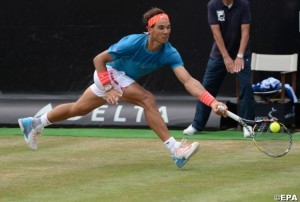By Randy Walker
@TennisPublisher
Waking up and scrolling through the pages of my book “On This Day In Tennis History” – or swiping from your Iphone via the mobile app – always delivers an interesting nugget about tennis history.
June 15 was no different.
It was interesting to read that on June 15, 2008, Rafael Nadal won his first career grass court title when he defeated Novak Djokovic 7-6 (5), 7-5 in the final of Queen’s Club in London. The seven-year anniversary of this hallmark title came a day after Nadal won, once again on grass, in an almost equally-important tournament win in Stuttgart. Nadal’s confidence has been in shatters this year, his ranking dropping to his current perch of No. 10 and astonishingly not winning any of the spring European clay court championships and suffering on his second loss ever at Roland Garros to Djokovic in the French Open quarterfinals. When Nadal won at Queens in 2008, he went on to win his first Wimbledon title three weeks later, defeating Roger Federer in one of the greatest tennis matches of all time. Will this grass court title Stuttgart catapult Nadal back to a consistent winning form? We shall see.
It was also remarkable to also read about Nadal’s seven-year grass court anniversary that when he won at Queen’s Club in 2008, he was the first Spaniard to capture a grass-court title since Andres Gimeno won the title in Eastbourne, England in 1972. It seems remarkable that for 36 years, no Spanish player won on a grass court, although the grass court season was only four weeks long since 1988. Up until 1974, three of the four major championships (Wimbledon and the U.S. and Australian Opens) were played on grass and two majors were played on grass from 1975 until 1987 (Wimbledon and Australian Open.)
However, since Nadal’s win at Queens in 2008, Spain has won seven ATP singles titles on grass. Nadal added three more grass titles since then – the 2008 and 2010 Wimbledon titles and his 2015 title in Stuttgart. David Ferrer won the title in s’Hertogenbosch, Netherlands in 2012 and Roberto Bautista Agut took the title there in 2014. Feliciano Lopez also won the title in Eastbourne in 2013 and 2014.
What these victories tell me is something that is reflective in the book “The Secrets of Spanish Tennis” by Chris Lewit (for sale here: http://www.amazon.com/dp/1937559491/ref=cm_sw_r_tw_dp_q1UFvb0QPEW8Y via @amazon) – the Spanish players are becoming more and more successful on faster surfaces after having most of their success primarily on clay.
Presenting Lewit with these figures on Spanish success on grass courts, Lewit reinforced Spain’s recent focus on training on faster court surfaces.
“Historically, Spanish players have struggled to compete on faster surfaces but since the late 80’s and early 90’s, that trend started to change,” Lewit said. “Players like Carlos Moya and Juan Carlos Ferrero had great success on faster surfaces, and coaches in Spain started to train players on more of a balance of fast and slow courts. Today, modern Spanish players are adept at multiple surfaces and leading Spanish academies are installing more and more hard courts.”
An interesting perspective Lewit put forward was that for developing players, in the opinion of most elite tennis coaches, is that it is easier to transition one’s game from slow clay courts to faster surfaces than vice versa. With American tennis players primarily playing on faster hard courts, this would, in theory, explain while Americans have struggled for decades on clay courts, while clay court players from Europe and South American have found relatively more success on faster surfaces like grass, hard courts and indoors.
“Whereas 20 or 30 years ago, the typical Spanish training center would be purely clay court training, most high performance centers nowadays have a good amount of hard courts and rotate the players regularly to play on both,” Lewit said. “In addition, the younger modern generation of Spanish coaches are teaching players to play closer to the baseline and fight more for court position, as opposed to the traditional Spanish style of giving ground and moving very deep into the backcourt. Modern Spanish players will give ground more reluctantly than their predecessors.”
Keep your eyes on how the Spaniards do on the slick grass of Britain the next few weeks and on the fast U.S. hard courts this summer. Will it prove to be the surface of redemption for Rafael Nadal?

